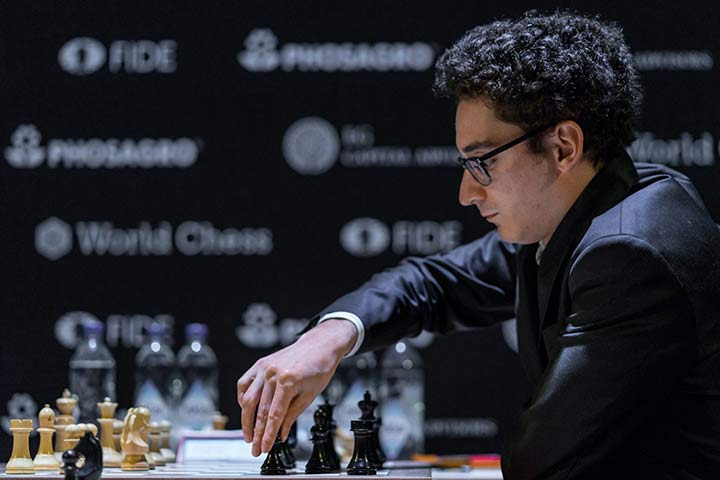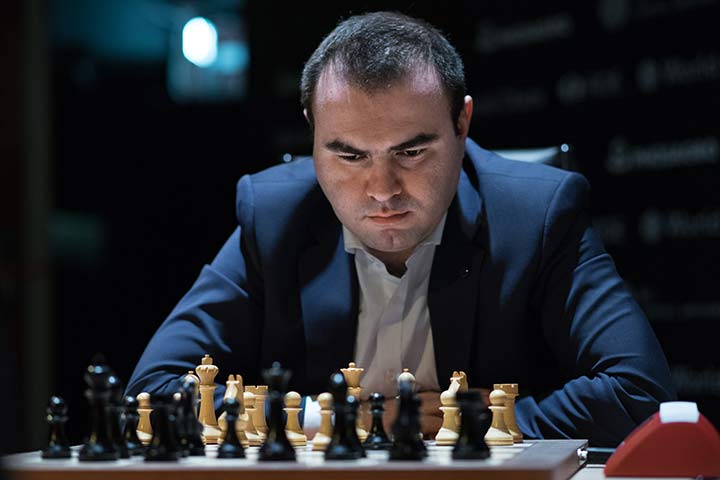Advantage Caruana
One controversial aspect of the Candidates Tournament is that any ties will be settled by a system of tiebreak criteria, and now certainly not over the board in a playoff.
Standings after the penultimate round
Chances clearly now favour Caruana, the leader by half a point, but things are still far from decided. In many tiebreak scenarios, it's Mamedyarov with an edge.
What to look for in round 14
It will be interesting to see how Caruana handles the situation. He's in much better shape than he was heading into the final round of the 2016 Candidates in Moscow, when he faced Karjakin, needing to win. This year, a draw would give him reasonably good chances, and he has the black pieces. But nothing is certain, and he would, of course, prefer to have the luxury of playing for two results since he's untouchable with a win. Conversely, a loss would be a disaster.

Caruana plays black, but how much risk will he take? And what mood will Grischuk be in?
Sergey Karjakin vs. Ding Liren
Karjakin plays with white against Ding, and this game will be absolutely critical for both. Ding, a full point behind Caruana, must of course win, and then hope other results go his way. Karjakin has more routes to tournament victory. But he most likely has to win. The only scenario in which a draw is enough for Karjakin is if Mamedyarov and Caruana lose. But if Karjakin does win, then the pressure on Mamedyarov and Caruana will be huge.
Alexander Grischuk vs Fabiano Caruana
In the last round, Grischuk has white against Caruana. Grischuk's games have been wild and anything is possible. But one thing is certain: Grischuk is eliminated from any chance to win the tournament. The best he can do now is give his countryman Karjakin a big boost by beating Caruana.

Alexander Grischuk is out | Photo: World Chess
Vladimir Kramnik vs. Shakhriyar Mamedyarov
Mamedyarov has Black versus Kramnik, but a draw is unlikely to be enough, so he will have to play aggressively and keep his options open. Kramnik can help Karjakin considerably by beating Mamedyarov.
Levon Aronian vs Wesley So
This game between the two players at the very bottom of the standings has a tiny bearing on the Sonnenborn-Berger scores (see below), but not enough to influence the tiebreak calculation. And with nothing at stake for the players individually, look for a fairly quick draw after a long tournament that both players would be glad to forget.
How will a tie be broken?
There are three levels of tiebreaks, but the odds are we'll only need the first to determine the winner.
Tiebreak criteria #1: Direct encounter
There is a reasonably high probability that two or more players will end up with the same score. But with a relatively high number of decisive games in Berlin, many such ties will actually be decided on this first criterion, the player's head-to-head results. That's good for Karjakin in a tie with Caruana as the Russian's twelfth round win would throw the tournament his way. However, Karjakin does not want to be the first with Mamedyarov: here too there was a draw and a win, but the win went to Mamedyarov. Mamedyarov's score with Caruana is equal — two draws. That means if the three of them tie, either on 8 or 8½ points (and it doesn't matter which), then Mamedyarov wins.
There's one more remote scenario that could be decided here. If Ding beats (and eliminates) Karjakin, Mamedyarov draws and Caruana loses, then we would have a three-way tie on 8 points. In this case Ding's head-to-head score against Mamedyarov and Caruana is superior. Still, on balance, advantage Mamedyarov.
Tiebreak criteria #2: Wins
If the direct match between the tied players does not result, the number of winning entries in the tournament counts. Here, Karjakin and Caruana have won four games so far, more than any other player in the tournament. However, if Mamedyarov wins, he will also have four wins. So a scenario in which Mamedyarov and Caruana tie, it will need to be broken by the third and final criteria. The exception would be if Caruana loses, and Mamedyarov and Karjakin both draw. Then there would be a three-way tie on 8 points, and Mamedyarov wins, as noted above. Advantage Mamedyarov.

Mamedyarov is favoured in many tie scenarios | Photo: Niki Riga
Tiebreak criteria #3: Sonneborn-Berger score
Should the number of games won bring no decision, then we go to the Sonneborn-Berger score. This could happen if there is a two-way tie between Mamedyarov and Caruana on 8½ points. In this case, their results against the other players in the tournament come into play. The main idea is that points (wins or draws) scored against higher-ranked players in the standings are more valuable than those against players who performed poorly. The final calculation requires all results to be projected, but a Mamedyarov win which would be required would give him the tournament on S-B score over Caruana. Advantage Mamedyarov.
Playoff match
This was always extremely unlikely, but it remained theoretically possible going into Monday's round, albeit only in certain scenarios in which Mamedyarov and Grischuk were to tie for first. Had that happened, a playoff mini-match between the same players would have followed: Two rapid games with 25 minutes plus 10 seconds per move for the entire game. If both games are drawn, two blitz games with 5 minutes plus 3 seconds, and if still drawn, finally, a single sudden-death "Armageddon" game.
Just how unlikely was it? After twelve rounds, out of 6561 possible outcomes of the tournament, only seven scenarios would have resulted in a Mamedyarov vs Grischuk playoff. After Karjakin's draw in round thirteen, there were merely three possible playoff outcomes. And by the end of play Monday that number is zero.
Bottom line: There will be no playoff on Wednesday.
But who's the favourite?
Caruana is the clear favourite. But Karjakin is the only one among the three to have the White pieces in the final round. On the other hand, the players who have been given the burden of being considered a favourite so far have suffered. And so many of the scenarios are perfectly plausible. In any case, it remains exciting.
According to one observer's calculations, Caruana has greater than 50% chances to win, which increase to roughly 2/3 if he should draw against Grischuk tomorrow. Ding meanwhile has less than 2% chances, when one considers the general probability of wins, losses and draws in chess.
Corrections: As pointed out in the comments: If Ding beats (and eliminates) Karjakin, Mamedyarov draws and Caruana loses, Ding wins. For Karjakin to win by drawing, Caruana would also have to lose.
Links


























